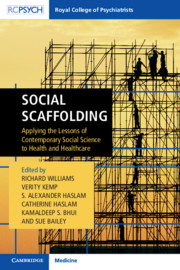Section 2 - Scoping
Published online by Cambridge University Press: 14 June 2019
Summary
Public health is defined by the UK’s Faculty of Public Health as ‘The science and art of promoting and protecting health and well being, preventing ill health and prolonging life through the organised efforts of society’.
This definition locates the causes of ill health and the remedies in the realms of personal and societal agency, and not only in the remit of health practitioners. Although the latter have a role as members of society to make prevention a reality for themselves, families and communities, they play a special part in preventing further ill health for people who suffer mental illness and are seeking help for it.
Other chapters in this book attend to the relational and social fabric that enables people to flourish; it is made of good and trusting relationships, and material conditions that permit thought about purpose and meaning beyond survival.
- Type
- Chapter
- Information
- Social ScaffoldingApplying the Lessons of Contemporary Social Science to Health and Healthcare, pp. 43 - 128Publisher: Cambridge University PressPrint publication year: 2019



